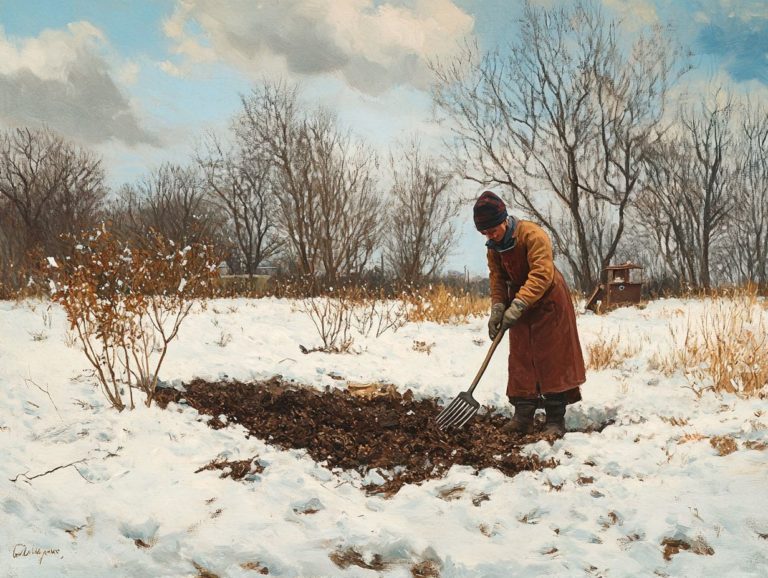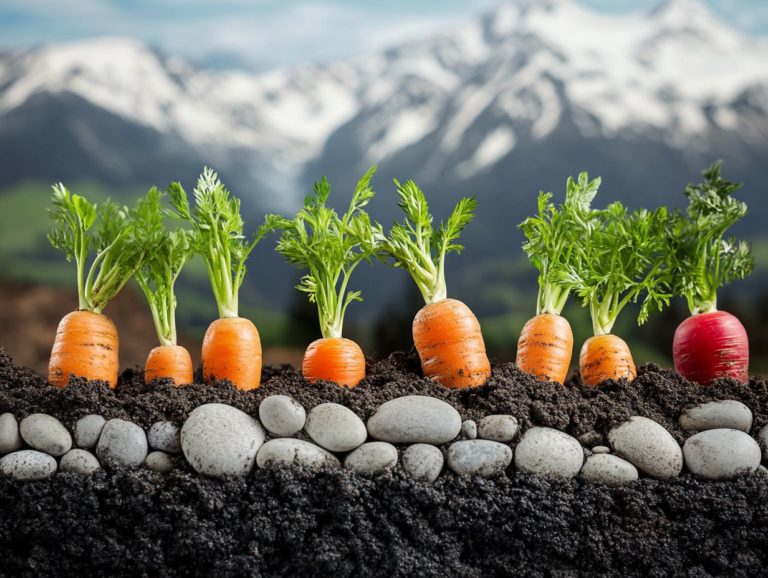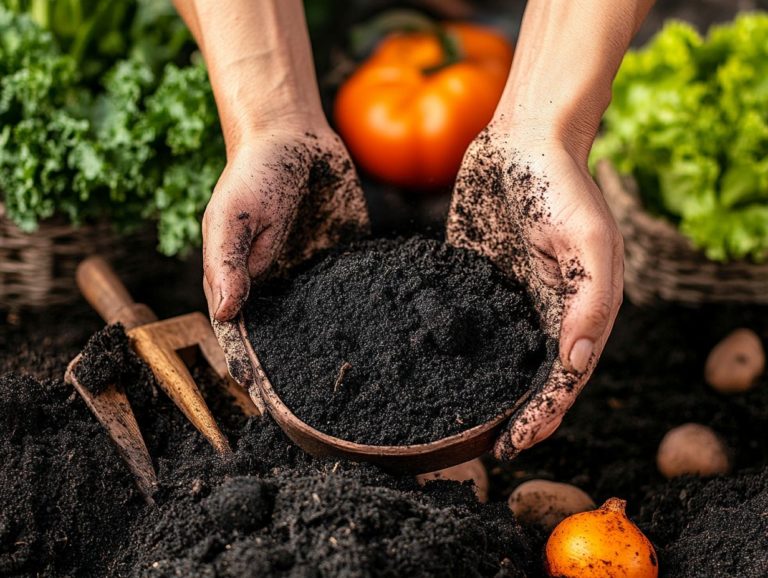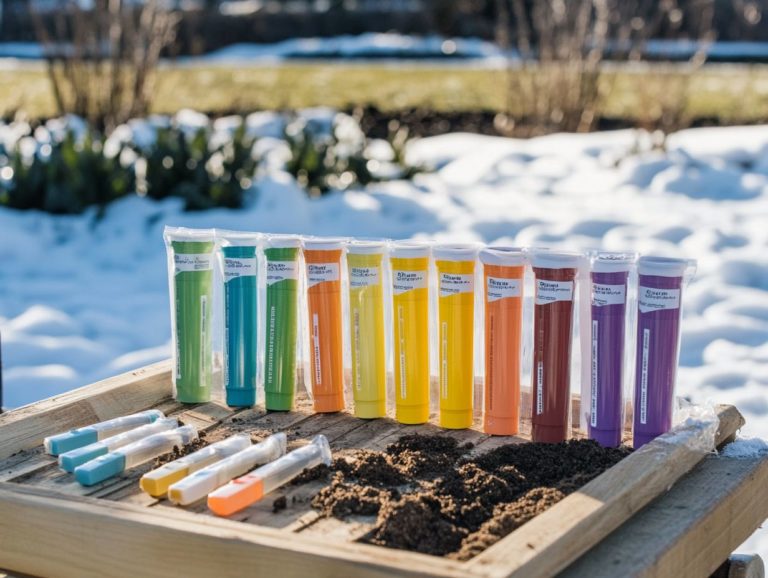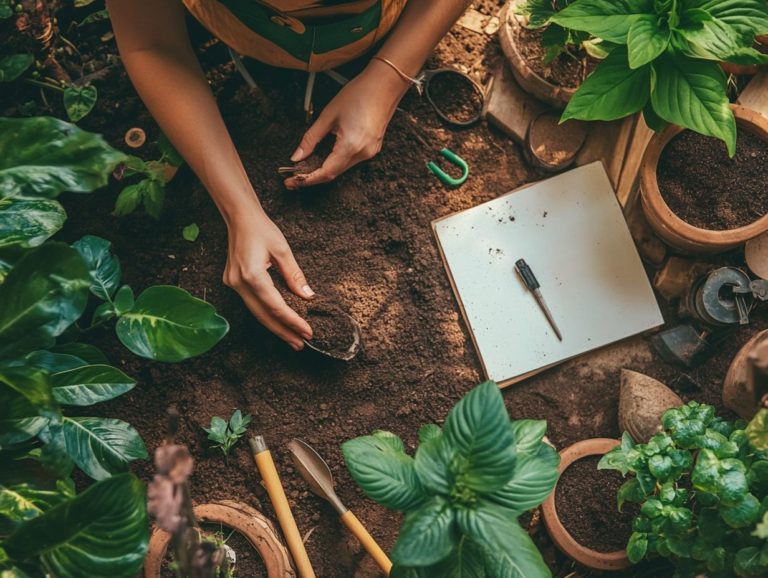Choosing the Right Soil for Cold-Climate Gardening
Gardening in cold climates presents a distinctive blend of challenges and rewards. When the temperature drops, your garden needs your attention! Understanding the specific needs of your garden is essential.
From selecting the ideal type of soil to ensuring proper moisture retention, every detail counts. This exploration delves into the factors that influence your soil choice, including climate, drainage, and nutrient levels. It highlights the best soil types for cold-weather gardening and offers valuable tips on preparing and maintaining your soil for optimal plant growth.
Whether you re a seasoned gardener or just starting out, you ll discover insights to help your garden flourish even in chillier conditions. Don t wait until summer! Start preparing your soil now for a thriving garden.
Contents
- Key Takeaways:
- Understanding Cold-Climate Gardening
- Factors to Consider When Choosing Soil
- Types of Soil Suitable for Cold-Climate Gardening
- Preparing and Maintaining Cold-Climate Garden Soil
- Frequently Asked Questions
- What factors should I consider when choosing soil for cold-climate gardening?
- What type of soil is best for cold-climate gardening?
- Can I use regular garden soil for cold-climate gardening?
- Do I need to fertilize my soil in a cold-climate garden?
- How often should I water my garden in a cold climate?
- Can I use mulch in a cold-climate garden?
Key Takeaways:
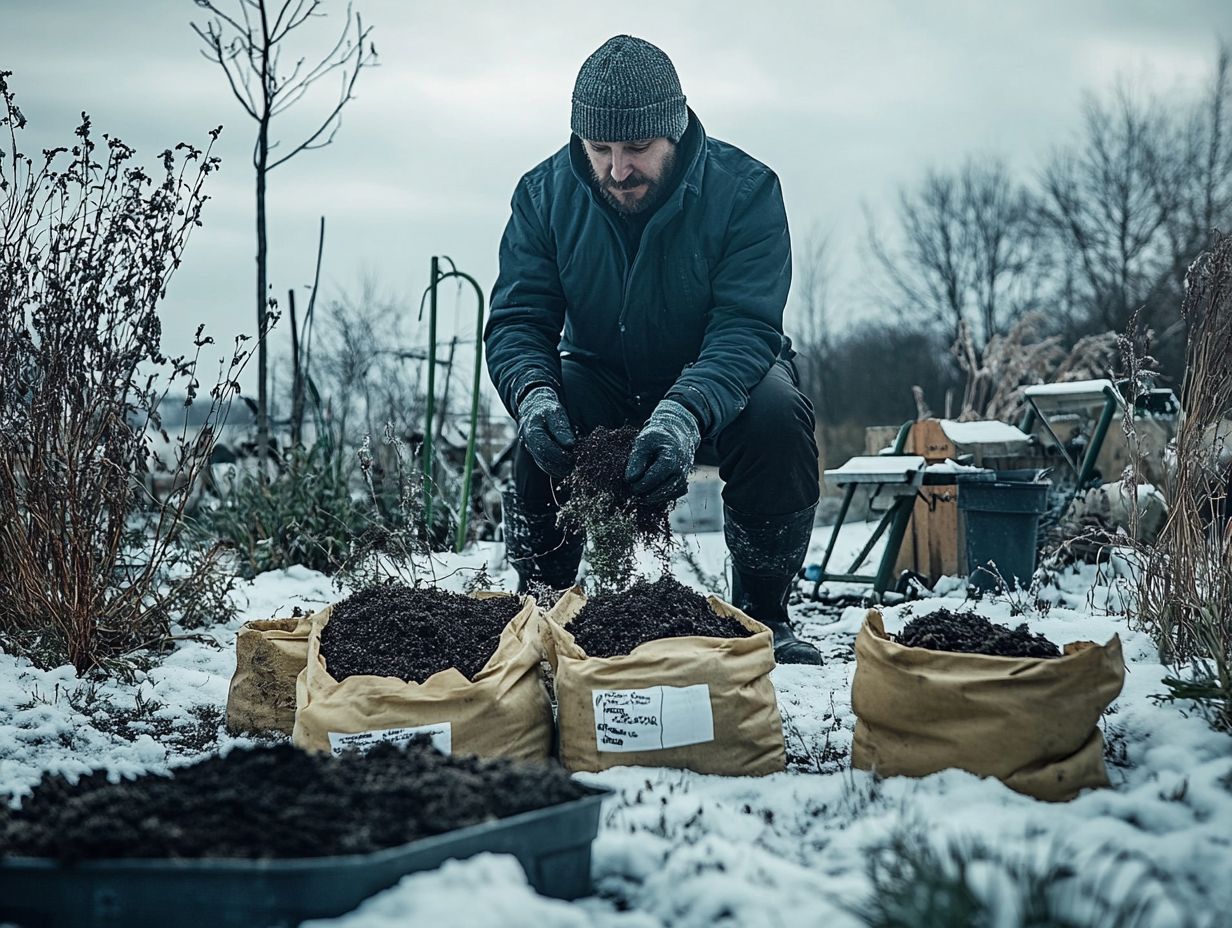
- Choose soil with good drainage and water retention for cold-climate gardening.
- Consider the specific climate and temperature of your region when choosing soil for your garden.
- Amend soil with organic matter and use proper mulching techniques to maintain soil moisture and temperature for optimal plant growth.
Understanding Cold-Climate Gardening
Cold-climate gardening offers a distinct set of challenges and opportunities. To thrive in regions marked by harsh winters and shorter growing seasons, you must skillfully navigate these by following soil preparation tips.
In places like Wyoming, understanding your specific garden zone is essential. This knowledge dictates which plants can flourish and the optimal times for planting. Being aware of your first frost dates helps you time your seed starts and safeguard your crops, making insights from local gardening experts particularly valuable.
You can use techniques like starting seeds indoors and tools that help you grow plants longer to maximize your gardening potential, even in the face of climate constraints.
What Makes Gardening in Cold Climates Unique?
Gardening in cold climates presents unique challenges that demand thoughtful planning and adaptation. To ensure your plants not only survive but thrive, it’s crucial to learn how to choose the best potting mix for cold gardens.
With factors like shorter growing seasons, unpredictable weather patterns, and the necessity for protective strategies such as raised beds or cold frames, success in cultivation hinges on your approach.
You ll often contend with frost that can sneak in early during spring or linger late into fall, complicating your growing cycle. By installing raised beds, you can enhance drainage and warmth in the soil, creating a more hospitable environment for your plants.
Additionally, using tools like row covers and greenhouses provides essential warmth and protection against biting winds and sudden temperature drops. Choosing heirloom seeds, which are bred specifically for hardiness, is another savvy tactic. This allows you to cultivate a variety of vegetables and flowers that can withstand the chill, maximizing your gardening efforts despite the inherent challenges of your environment.
Factors to Consider When Choosing Soil
Selecting the appropriate soil is paramount to achieving success in cold-climate gardening. For optimal results, refer to guides on choosing the right soil for cold-climate plants, as it directly influences water retention, drainage, and the availability of essential nutrients for your plants.
By familiarizing yourself with various soil types, their preparation methods, and the art of amending them with organic matter and compost, you can significantly enhance the health and yield of your garden.
Climate and Temperature
Climate and temperature play a crucial role in determining which plants will flourish in your garden, especially in colder climates like Wyoming. Understanding your specific plant hardiness zone the average lowest temperature that a plant can withstand is essential. With this knowledge, you can choose the right crops and time your planting schedules around first frost dates. This maximizes yield and ensures your plants survive.
In these regions, sudden temperature fluctuations present significant challenges. It s important for you to opt for cold-tolerant species to navigate these conditions effectively. Grasping the intricacies of hardiness zones not only informs your plant selections but also helps you anticipate potential weather-related setbacks. Knowing which vegetables can endure colder nights allows you to plant strategically, minimizing the risk of frost damage.
Using techniques like season extension through hoop houses or cold frames can enhance your gardening success in these harsher climates. This approach sets you up for a fruitful and sustainable gardening adventure, allowing you to cultivate a thriving garden despite the challenges presented by the environment.
Drainage and Water Retention
Effective drainage and water retention are essential elements for thriving in cold-climate gardening. These factors profoundly influence plant health and overall productivity. By understanding the nuances of different soil types and implementing techniques like raised beds, you can expertly manage excess moisture while ensuring your plants receive adequate hydration.
In colder regions, soil behaves uniquely depending on its texture and composition, which can significantly impact your watering schedules and plant choices. For instance, sandy soils drain rapidly and may necessitate more frequent watering, whereas clay soils retain moisture but can lead to waterlogging if not managed properly.
Raised beds offer a superior solution, enhancing both drainage and aeration. This method allows you to manipulate soil conditions with greater precision. By elevating the planting area, raised beds facilitate efficient moisture control, creating a nurturing environment where a variety of plants can flourish, even amidst challenging climatic conditions.
Soil Nutrients and pH Levels

Soil nutrients and pH levels are essential for the health of your cold-climate garden. They influence everything from seed germination to final yields. Regularly testing and amending your soil s organic matter will help you achieve the ideal nutrient balance and pH levels that various plants crave.
In these challenging environments, remember that nutrient availability can be greatly impacted by temperature fluctuations and moisture levels. Conducting soil tests something you can easily do with at-home kits or through local extension services will give you a clearer picture of any nutrient deficiencies and pH imbalances.
Once you understand your soil s needs, you can enhance it with organic amendments such as:
- Bone meal
- Blood meal
- Well-rotted manure
These additions will enrich your soil effectively. Plus, establishing a compost pile not only recycles kitchen scraps but also improves soil structure and fertility over time. It becomes an invaluable resource for cultivating vibrant, productive gardens, even in the face of harsh climate conditions.
Types of Soil Suitable for Cold-Climate Gardening
Understanding the types of soil most suitable for cold-climate gardening is crucial for nurturing healthy plant growth and optimizing yield. For more insights, refer to understanding soil needs for cold-climate plants, as loam, sandy, clay, and peat soils each possess distinct characteristics that affect water retention, drainage, and nutrient availability. Selecting the right soil type aligned with your gardening goals can significantly enhance your success.
Start testing your soil today and transform your gardening experience!
Loam Soil
Loam soil is your best friend for a thriving garden! It’s often hailed as the ideal choice for your gardening endeavors, thanks to its well-balanced mix of sand, silt, and clay. This perfect mix gives your garden the best of both worlds: great drainage and rich nutrients.
This unique blend allows water to flow freely through the soil while keeping essential nutrients close at hand. For gardeners in colder regions, this offers a significant advantage, preventing waterlogging that can damage delicate plant roots during the winter months.
Loam soil s ability to maintain moisture levels means your plants receive a consistent supply of nutrients, even as temperatures shift. By enriching this soil type with organic matter like compost or leaf mold, you can further enhance its structure and fertility. This fosters a healthy root system and promotes vigorous plant growth.
With all these remarkable qualities, it s no wonder loam soil stands out as a premier choice for anyone eager to nurture a flourishing garden, even in challenging climates!
Sandy Soil
Sandy soil stands out with its coarse texture and exceptional drainage properties, making it an ideal choice for certain plants in colder climates. However, you ll need to manage watering meticulously to prevent nutrient leaching.
This type of soil dries out quickly, so be attentive to your watering routines to ensure your plants don t experience drought stress. Because sandy soil typically has a low nutrient retention capacity, enriching it with organic matter like compost or well-rotted manure can significantly boost its fertility.
Mulching helps retain moisture and provides gradual nutrient release as it decomposes. For optimal growth, choose plants that thrive in sandy conditions, and keep a close eye on soil moisture levels to adjust your watering frequency as needed.
Clay Soil
Clay soil can be quite the challenge with its dense texture and poor drainage, but it can be transformed into a thriving environment for cold-climate gardening. The key lies in improving its structure and enhancing its water retention capabilities.
This type of soil has a knack for compacting easily, trapping moisture and creating waterlogged conditions that can suffocate plant roots. As a gardener, you might find yourself grappling with the difficulties of cultivating a vibrant garden in such an environment.
To turn the tide, consider incorporating organic matter like compost or well-rotted manure. This addition not only enhances drainage but also infuses essential nutrients into the soil. You might also want to explore creating raised beds to alleviate drainage problems while warming the soil.
Using methods to aerate like using a garden fork to break up that dense soil will significantly improve overall aeration. This makes it easier for roots to penetrate and access the nutrients they need to thrive.
Peat Soil
Don’t miss out on the benefits of peat soil it s a game-changer for your winter garden! Peat soil is a treasure trove of organic matter, thriving in moisture retention. It s an exceptional choice for those cold-climate plants that flourish in consistently damp conditions.
This remarkable quality ensures that vital moisture remains accessible to the roots during those brisk months when evaporation rates dip. By integrating peat soil into your vegetable gardening tips, you can cultivate a perfect environment for an array of perennials and annuals, such as heather, blueberries, and some ferns.
Mixing peat with your native soil not only enhances its texture but also amplifies its nutrient content. This results in healthier, more resilient plants capable of withstanding cold weather and adapting to the first frost dates in your region.
Choosing the Right Soil for Specific Plants

Choosing the right soil type for your plants requires understanding what nutrients your plants need and soil acidity levels. This ensures optimal growth and productivity in colder climates like Wyoming.
Take root vegetables like carrots and potatoes, for example. They thrive in loose, sandy loam that drains efficiently, allowing them to develop deep roots.
On the other hand, if you’re nurturing plants like blueberries, you’ll want sandy, acidic soil rich in organic matter to meet their specific nutritional requirements. This is especially true if you plan on growing tomatoes, cucumbers, zucchini, and onions.
In colder regions, enhance your soil by adding compost or peat moss. These improve both texture and nutrient content, providing essential support for your plants. Regularly monitoring and adjusting soil pH is equally vital. Sulfur powder can be your best friend for increasing acidity in acid-loving varieties, while lime can help elevate alkalinity for others, catering to a range of growth needs, including those of currants.
Preparing and Maintaining Cold-Climate Garden Soil
Preparing and maintaining the soil in your cold-climate garden is essential for promoting healthy plant growth and maximizing yields. Understanding the role of soil in sustainable cold-climate gardening requires regular amendments with organic matter and effective drainage solutions tailored to your gardening challenges.
Employing techniques like creating a compost pile and mulching enhances soil quality and boosts your winter gardening endeavors, creating an ecosystem that supports your overall gardening efforts.
Amending Soil for Optimal Growth
Amending your soil for optimal growth means adding organic matter and essential nutrients to enhance its structure and fertility. This ensures your plants get everything they need to thrive, even in chilly climates, which is crucial as you consider your planting schedules.
This process not only enriches the soil but also boosts its moisture retention capabilities and promotes healthy root development.
Incorporate well-decomposed compost, leaf mold, or aged manure to significantly elevate the organic matter content. These amendments foster beneficial microbial activity, transforming nutrients into forms that your plants can easily absorb.
Introducing materials like peat moss or shredded bark can enhance aeration and drainage, allowing roots to access both water and air key ingredients for robust, healthy growth. Understanding your plants specific needs and local conditions is crucial in selecting the right amendments, especially when considering your watering needs. This ultimately enriches the entire ecosystem of your garden.
Proper Mulching Techniques
Proper mulching is vital for conserving soil moisture, suppressing weeds, and boosting your garden s health, especially during the winter months. Act now to prepare for the first frost!
In these frigid regions, effective mulching can truly make a difference for your plants as they navigate harsh conditions. Organic mulches, like wood chips or straw, not only enrich the soil with nutrients as they break down but also form a protective barrier against temperature fluctuations.
On the other hand, inorganic options such as gravel or landscape fabric excel in moisture retention and weed suppression, which is vital for successful vegetable gardening.
When you apply mulch, aim for a thickness of three to four inches. This coverage protects your plants and prevents rot! This technique not only moderates soil temperature but also safeguards roots from extreme frost, significantly enhancing your garden’s vitality throughout the winter season, providing a buffer against gardening challenges.
Managing Soil Moisture and Temperature
Managing soil moisture and temperature is crucial for successful cold climate gardening. Small fluctuations can significantly impact your plant growth and yield, so monitoring is key, especially during spring and Memorial Day.
To create optimal growing conditions, consider implementing consistent irrigation practices. A method of delivering water directly to plant roots, drip irrigation can be especially effective, addressing watering needs.
Utilizing appropriate drainage solutions prevents waterlogged soil. This protects roots from rot during spring thaws or heavy rainfall.
Raised beds offer another advantage, promoting better drainage and warming the soil more quickly in cooler weather. This gives your plants a head start on the growing season, particularly when considering planting schedules.
These strategies significantly impact the health and productivity of your plants, enabling you to reap bountiful harvests of crops like corn, beans, and Swiss chard even when faced with challenging climatic conditions.
Frequently Asked Questions
What factors should I consider when choosing soil for cold-climate gardening?
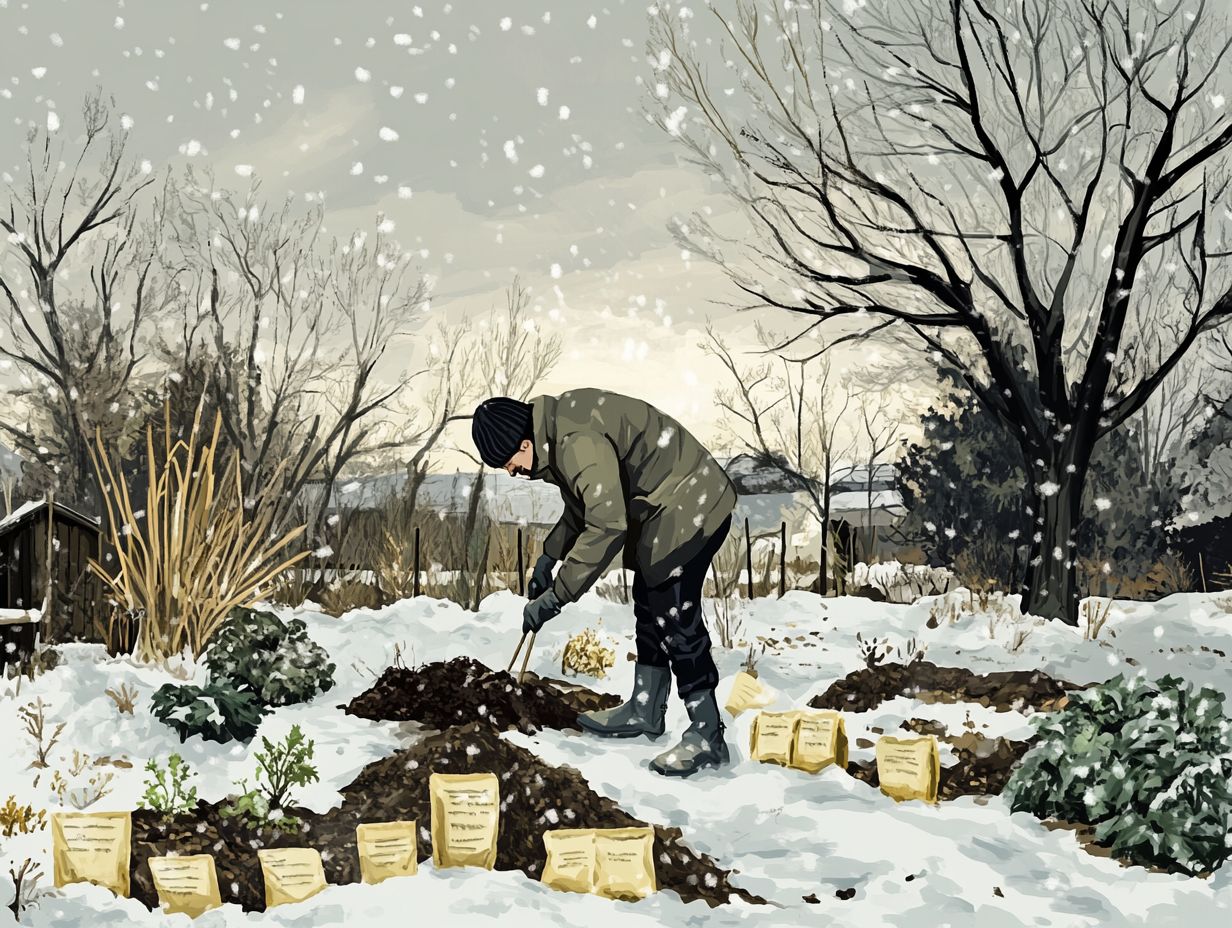
Choose soil for cold climate gardening based on drainage, nutrient content, and texture. For more insights, check out how to select the right soil for cold gardens. Cold climates often have shorter growing seasons and harsher conditions, so selecting the right soil can greatly impact your gardening challenges and success.
What type of soil is best for cold-climate gardening?
A well-draining, nutrient-rich soil with a slightly acidic pH is ideal for cold climate gardening. For the best results, consider how to choose the right soil for winter gardening, as this type of soil allows for proper drainage and water retention while providing essential nutrients for plant growth. A loamy or sandy loam soil is often recommended for cold climates, particularly for crops like potatoes and onions.
Can I use regular garden soil for cold-climate gardening?
Regular garden soil may not be suitable for cold climate gardening. It can become compacted and retain too much moisture in colder temperatures. It’s best to use soil specifically designed for cold-climate gardens or amend your existing soil with compost and other organic materials that improve its texture.
Do I need to fertilize my soil in a cold-climate garden?
Yes, fertilizing your soil is necessary for successful cold climate gardening. To enhance your efforts, consider selecting plants for cold climate community gardens that thrive in these conditions. Choose a slow-release or organic fertilizer, as chemical fertilizers can harm beneficial microbes in the soil. Opt for a fertilizer with balanced levels of nitrogen, phosphorus, and potassium to support plants like tomatoes and corn.
How often should I water my garden in a cold climate?
In a cold climate garden, water less frequently but deeply. This accommodates the watering needs of various crops, allowing the water to reach the root system and encouraging deeper root growth. Watering in the morning is ideal, as evening watering can lead to excess moisture and increase the risk of fungal diseases.
Can I use mulch in a cold-climate garden?
Yes, using mulch in a cold-climate garden can greatly benefit your plants. Mulch helps retain moisture in the soil, regulates soil temperature, and suppresses weed growth, which is critical when preparing for first frost dates. Organic mulch, such as shredded leaves or straw, can also add nutrients to the soil as it decomposes.

